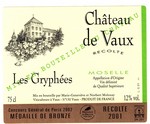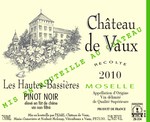
| The tiny Moselle AOC (just 100 acres) is tucked up in the northeast corner of France, just over the Vosges Mountains from Alsace, near the Luxembourg border. Although an important wine region up to the mid-nineteenth century, phylloxera, industrialization and two world wars brought near obliteration of viticulture around Metz, in Lorraine, whose production was sold to make champagne until 1910, when the A.O.C. Champagne was created. Marie-Geneviève and Norbert Molozay discovered the Château de Vaux in September 1999. They saw extraordinary potential in the vineyard, ideally located in the hills of Vaux, Jussy, Lessy and Vic-sur-Seille, offering a complete palette of soils and grape varieties. At the time, the Moselle vineyards were spread over 39 hectares, five and a half of which belonged to Château de Vaux. Consolidation of the parcels ensued, the vineyard grew, agricultural techniques were improved and the cellars were restored. Together, Marie-Geneviève and Norbert resuscitated France’s most northerly appellation. Farming/winemaking practices: certified organic since 2014. The wines are vegan, no animal derivatives are ever used. 2016 vintage notes: 2016 was placed under the sign of excesses. Excess of water in May and in June - it was very difficult to find dry days to carry on the treatments, but eventually almost all of the clusters were saved and floraison happened normally, and excess of sun and especially heat in August, with 3 days at almost 40°C - which stopped the maturation process. Fortunately a small amount of rain in September restarted the process, and the grapes were able to slowly mature during a beautiful Indian summer. October was exceptional and the grapes achieved perfect maturity. The harvest began on October 4th, the latest ever. Overall, only 7% of volume was lost, as the organically farmed grapes were able to withstand the challenges of the spring. 2016 is a brilliant vintage. |
| Château de Vaux Website |
 |
| Moselle Blanc - "Les Gryphées" |
| 30% Auxerrois, 30% Muller Thürgau (a crossing of Riesling and Chasselas), 30% Pinot Gris and 10% Gewürztraminer. The vines grow on rocky terraces planted on hillsides west of the Moselle River, with clay-limestone soils. South-southeast exposure and a mix of oceanic and continental climate. Each grape variety is separately harvested according to its ripeness, and is immediately pressed in a pneumatic wine press. Fermentation is carried out in temperature-controlled tanks at low temperature, with final blending in February. Les Gryphées shows notes of peaches and white flowers on the nose, followed by ripe fruit on the palate and apricot of the finish. |
 |
| Moselle Pinot Noir - "Les Hautes-Bassières" |
| 100% Pinot Noir - "Hautes Bassières" is a lieu dit. Harvesting is done by hand. The grapes are put into vats after destemming. The grapes are left to macerate with daily pigeages for three weeks. After a long cuvaison, the juice of the pressed grapes is drawn and the marc is pressed. The free-run and press wines are then blended. The wines are entirely aged in barrels of varying origins, ages and degrees of barrel heating or “toasting”. The goal is to have complexity but by no means forced extraction. The wine is matured in casks for 12 months. Blending and bottling is done at the Château at the end of September. Pale rubis color, aromas of black cherry, peppery carnation and peony, silky tannins. |
| Copyright © 2002-2017 VOS Selections, Inc. |